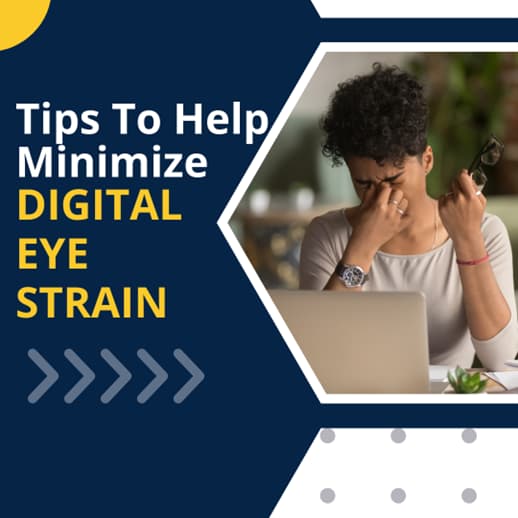
In today’s digital age, we all find ourselves constantly in front of screens, whether for work, leisure, or to keep up with our daily lives. It’s a reality we all share. Researchers have found that just two hours of screen time per day can lead to a 90% risk of developing digital eye strain, a condition many of us may be experiencing without even realizing it.
Why Do Digital Screens Cause Eyestrain?
You normally blink 15-20 times a minute, which often spreads tears evenly over your eyes, keeping them from getting dry and irritated. Studies have shown that people blink less than half as frequently when reading or watching on a screen.
Symptoms of Digital Eye Strain
There is an excellent chance that the digital eye strain condition commonly affects many patients without realizing it. Here are some of the symptoms associated with digital eye strain:
- Dry eyes
- Eyestrain
- Frequent headaches
- Blurred vision
- Itching or burning sensation in the eyes
- Neck and shoulder pain
Working from home on your computer or at the office, checking your email, or scrolling through social media on your smartphone could result in having these symptoms if proper techniques are not in place to ensure your productivity does not suffer impact. Here are a few tips to help minimize digital eye strain:
Organize Your Workspace At An Eye Comfort Level
Double-check your posture to ensure there is enough space between you and your computer. Most people find it more comfortable to view their laptops when their eyes are looking downward. The proper viewing distance for the computer should be 20 degrees below eye level, measured from the center of the screen and 20 inches from the eyes. This angle helps reduce strain on your eye muscles and can prevent discomfort during prolonged screen use.
Check Your Lighting
It is essential to customize your lighting needs. Position the computer screen to avoid glare, particularly from room lighting or windows. A glare filter for your screen would also be a good alternative.
Give Your Eyes A Quick Break
Make the 20-20-20 rule part of your daily routine. This rule is designed to combat digital eye strain, which often occurs because people blink less often while looking at digital screens. To give your eyes a break, every 20 minutes, look at something 20 feet away for at least 20 seconds. This allows your eyes to relax and refocus, reducing the strain caused by prolonged screen time. Incorporating this rule into your day can significantly improve your eye health.
Adjust Your Smartphone Settings
Lower the color temperature of your screen. The screen should be lighter or darker than your surroundings. Also, raising the contrast and making the text larger will ensure that your smartphone device settings are optimal for eye health. These adjustments can reduce the strain on your eyes, making it easier to read and view content on your device without discomfort or fatigue.
Incorporating these few eye health tips above and adjusting your daily habits on how you use your digital devices can be easier on your eyes. With these simple adjustments, you can take control of your eye health and reduce the impact of digital eye strain.
Don’t Forget To Schedule Your Eye Exam
If you’re experiencing eye discomfort, vision changes, or headaches, don’t hesitate to make an appointment with your eye doctor. Regular eye exams are crucial for maintaining good eye health. To make the most of your appointment, be sure to list any symptoms you’ve been experiencing and your key medical information, and keep a journal of the time you spend on activities that strain your eyes. Also, jot down any questions you may have for your eye doctor. Remember, we’re here to help you maintain your eye health, and we encourage you to be proactive when scheduling regular eye exams.
We Are Honored To Be Your Partners In Lifelong Eye Health!

References: American Academy of Ophthalmology and the American Optometric Association. This blog provides information and discussion about eye health and related subjects. The content provided within this blog and any linked materials are not intended and should not be considered medical advice. If the reader or any person has a medical concern, they should consult with an appropriately licensed physician.

